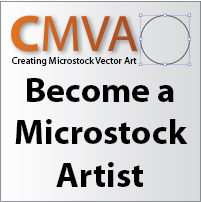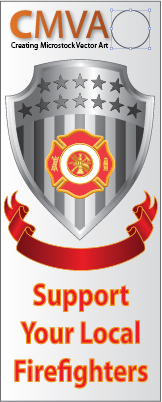Creating a Vector Travel Mug in Illustrator
(available in video format here)
Sometimes it can be a challenge to choose subject matter for your vector illustrations. One option that you have is to simply look around you. Sometimes you can find a subject right under your nose. I took a photo of this travel mug that is on my desk and at this moment filled with hot coffee.
You would be surprised at what is in your own house or apartment that you can use to create vector illustrations. Just be careful and do your research on the microstock sites to make sure the market is not over saturated. Still, don’t let that discourage you too much. I have created illustrations of the same subject mattert as many other artists and still had good sales on them. Each artist has his or her own interpretation and all are different. Just make it your own by giving it your own special touches.
You can right click on the image below and then choose Save Image As, save it to somewhere on your computer. A good place might be in your My Pictures folder or perhaps on your desktop.

In Illustrator open a new document.

In Illustrator go up to File in the top menu and click on Place.
This opens up a browse window where you can browse for your image. Select the image from where you saved it and click place.

Position the image where you want it on the artboard.
For purposes of this tutorial we will use the Essentials workspace. Go to Window in the top menu, click on Workspace and choose Essentials. The panels should appear on your workspace on the right.

These are the basic tools we might need and even though we won’t be using most of them it is a good habit to use a workspace where the tools are out of the way. Later on as you develope your skills you’ll probably customize that area in your own way.
Let’s lighten the image a little so we can see our vector lines more easily. Go to the panels on the right and choose Transparency. This expands the Transparency panel on the right.
Make sure you have the image selected using the selection tool. in the Transparency panel change the Opacity from 100% to 75%.

This will enable us to see the lines we are creating more easily. Once you have done this you can close the Transparency panel. You can see the image is now lighter.

Another way to help in seeing your lines is to change the color of the outlines. Select your pen tool first. Go to the panels on the right again and select Color. This opens the color panel. First let’s get rid of any fill color which we don’t need for now. Click on Fill and below that click on None.

Next click on Stroke and in the colors section choose something that will be easy to see against the background image. I’m going to select a bright blue color. Use whatever color works best for you.

Now we’re ready to start recreating the logo in vectors. Go to your Ellipse Tool.

Create an ellipse along the outside rim of the lid. Don’t worry if it isn’t perfectly conformed to the lid in the photo. Just make sure the width and height are correct.

Copy (Ctrl+C) and Paste in Front (Ctrl+F) this object, move it down to the bottom of where the lid attaches to the mug. Using the Selection Tool grab the top and stretch to match the line in the photo.

Go to the Rectangle Tool.

Create a rectangle from the outside edge of the top ellipse to the outside edge of the bottom ellipse.

Go to Window in the top menu and select Pathfinder.

Select the lower ellipse and the rectangle and on the pathfinder palette click on Unite. This merges the two objects into one.

Select the top ellipse and copy it. With it still selected go to Object in the top menu select arrange and Bring to Front.

Next select both objects. On the Pathfinder palette click on Minus Front.

Paste in Front (Ctrl+F).

Paste in Front (Ctrl+F) again and move this ellipse down to the bottom of the black part of the mug. Use the Selection Tool to stretch the top or bottom so that it lines up with that part in the photo.

Create another rectangle from the widest point of the lower ellipse to just above it.

Select the rectangle and the lower ellipse and on the Pathfinder panel click on Unite.

Bring the middle of the three shapes that you’ve created to the front using the previous technique and copy it. Select the middle and lower objects and on the Pathfinder panel click on Minus Front.

Paste in Front (Ctrl+F).

Copy and paste the ellipse at the top and move it down to the base of the mug. Use the Selection Tool to fit it to the shape of the base.

Using the Pen Tool create an object from the base of the mug to the black lid section that looks something like this.

Use the same Pathfinder techniques that we used before to Unite the bottom ellipse to this shape. Copy the shape above it and bring it to the front. Use the Pathfinder to Minus Front that shape from the bottom of the mug. Paste in Front the upper shape.

Copy and Paste in Front the ellipse at the top. Use the Direct Selection Tool to size it to fit the inner ridge of the lid.

Paste in Front again. Move this new ellipse to fit the lowest shape inside the lip of the mug.

Copy this shape. Select both this object and the object representing the inner ridge of the lid. On the Pathfinder panel click on Divide.

Ungroup these objects and delete the lower section.

Paste in Front another copy of the smaller ellipse and use the same process to create the next section of the inner lid.

Using the same techniques create two more sections within the inner lid.

Next create the slider on the right side of the lid. With the Pen Tool make an outline around the whole shape. Since this is so hard to see you can do some personal interpretation as to how you want this shape to look.

Create this shape along the top of the previous one. It should extend above the slider.

Copy the slider and select both objects. Use the Pathfinder’s Divide option. Ungroup the objects and delete the upper unwanted section.

Create a smaller section within this object using the same technique.

Next, make an outline around the entire shape at the top of the handle of the mug.

This vector shape represents the sides of the upper handle. Extend it out from the previous shape.

By now you recognize that we extend it out so that we can use the Pathfinder Tool and the Divide option to create our new object. Select both objects, click on Divide in the Pathfinder panel, ungroup and delete the unwanted object.

Use the same process to create this object.

Create the lower part of the handle using the Pen Tool. Extend it into the two objects above it.

Select the two object above the one just created, Group them, Copy them and Bring to Front.

Now with this object still selected also select the bottom part of the handle. On the Pathfinder panel click on Minus Front. Paste in Front the grouped objects. Ungroup those objects.

Create two more sections on the right of the lower part of the handle using the Pathfinder Divide Tool as we did before.

Next create these two shapes on the left side of the handle in the same way.

All of our shapes are created and now is a good time to go back and fine tune everything and make sure the objects are aligned as you want them. Also add any additional objects that you think might enhance your vector design. For instance, I have added two more sections to the upper part of the outside black lid area.

Now it’s time to color our art. For information on how to use the color tools check out the tutorial Coloring Vector Art In Illustrator.
Click and drag to separate the Color, Swatches, Stroke and Gradient panels from where they are docked on the right and arrange them like so.

Using the Gradient Tool create a Gradient that looks something like this. It is done in CMYK colors using different tints of black. The tints are 100%, 90%, 100%, 86% and 100%.

Color this object with a two color gradient from 85% black to 100% black.

Make this one 75% black to 100% black.

Make this one 70% black to 90% black.

This one is a three color gradient the goes from 70% to 50% at (30% location), to 90%.

The very top of the lid is a three color gradient that goes from 90% to 30% to 90% at a 60% angle.

These two also have the 90% to 30% to 90% gradient but the angle is 0% and the location of the middle is at 75%.

These three objects are 95% black.

These three are 70% black.

The top of the handle is a 60% black.

This object is 85% black.

Make these two 90% black.

These two objects are 80% black.

For the bottom of the mug use a five part gradient with these position. The percentages are 10% , 60%, 25%, 30% and 10%.

Delete the background image of the mug. Select all of the objects, Copy them, Paste in Front and give everything no Fill and a 50% black stroke. Then you can go through your Illustration and eliminate any outlines that you don’t really need such as inside the lid and on the grip of the handle. You can also send some of the strokes to the back to help with the final look of your vector art. Another technique that can be useful is to Align Stroke to Outside or Inside in the Stroke panel. There is really no wrong way to do this, it’s up to the artist to create the final look of the illustration.

For a different way to create the silver bottom of this cup check out the tutorial Coloring With a Gradient Mesh in Illustrator.









